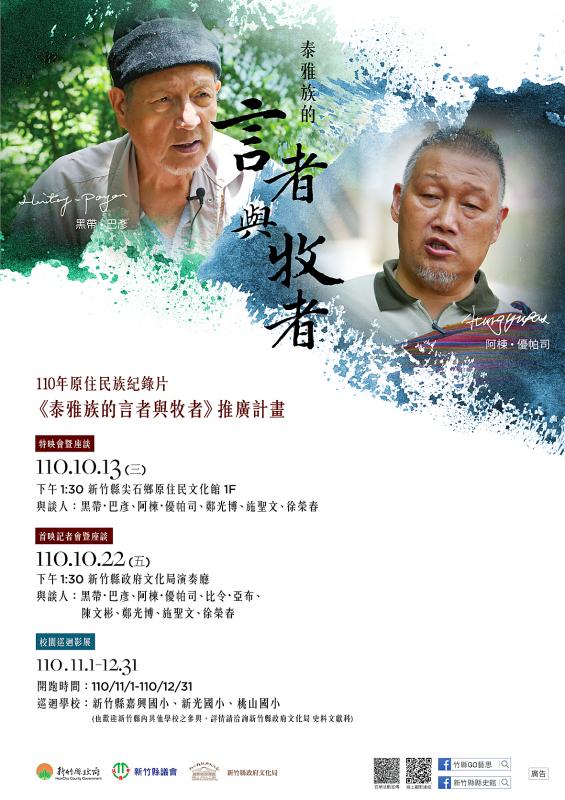The Hsinchu County Government has spent more than three years on planning and producing the Aboriginal documentary film A Speaker and Pastor of the Atayal. On Wednesday last week it held a special screening and discussion at the Aboriginal Culture Hall in Jianshih Township, inviting teachers and villagers from outlying villages to watch the film together. The film’s two main characters — Atayal elder Heitay Payan and pastor Atung Yupas — were both on hand to share the process and joy of making the documentary.
The special screening was opened with solemn, lilting Atayal chanting and a blessing ceremony. Hsinchu County Commissioner Yang Wen-ke took part in the event. He said that Hsinchu County is fortunate to have five major ethnic groups, namely Aborigines, Hakka, Hoklo, Han Chinese and new immigrants, and that the way these groups blend together is an expression of Taiwan’s beautiful and unique culture. He said that to pass down and promote precious cultural assets, it is essential to record the wisdom and life experiences of senior citizens, and the county government is duty-bound to carry out this cultural mission.
Hsinchu County Cultural Affairs Bureau Director Li An-yu said that for more than three years, in order to capture the life stories of Atayal elders, the documentary team and the Taiwan Atayal Sustainability Association had gone to great lengths to research and portray the migratory paths that Atayal groups have followed and record rare historical footage such as ancient Atayal tunes, playing the reed Jew’s harp, making traditional implements, and Aboriginal village rituals. They also revisited the scenes of historical events together with the elders, visiting Maqaw (Jhensibao) in Hsinchu County’s Jianshih Township, Shoufeng Township in Hualien County and Namasia District in Kaohsiung, among other places.

Photo courtesy of the Hsinchu County Government 照片:新竹縣政府提供
The “speaker” part of the film eloquently recounts the great efforts and aspirations of Heitay Payan, whose Chinese name is Tseng Tsuo-chen, as a cultural conservationist, ranging from applying his inborn talents to drawing pictures of cultural relics, recording cultural history by interviewing village elders and even writing Atayal-language entries in Wikipedia. He hopes that the young people of today will take full advantage of whatever opportunities they have to learn from their elders, so that the culture of their ancestors can be passed down.
The “pastor” part of the film starts out from the relationship between land and people, recounting how Atung Yupas, whose Chinese name is Chuang Chin-hsiu, has followed a political path to speak out for the realization of land justice and human rights for Aborigines.
For the discussion that followed the special screening, as well as the presence of the film’s two main characters, the organizers also invited co-directors Watan Kahat (Cheng Kwang-po), Shih Sheng-wen and Akira Chen to mingle with school principals, teachers and local residents. There will be a premiere showing and discussion at the Cultural Affairs Bureau’s performance hall in Jhubei City this Friday, and in November and December the film will be shown in the form of a touring film festival at Jiasing, Hsin Kuang and Taoshan elementary schools.
(Translated by Julian Clegg, Taipei Times)
新竹縣政府耗時三年多規劃製播的原住民族紀錄片《泰雅族的言者與牧者》,上週三在尖石鄉原住民文化館舉辦特映會與座談,邀請偏鄉教師及鄉親一同欣賞,兩位主角──泰雅族耆老黑帶‧巴彥,以及牧師阿棟‧優帕司,現身分享拍片歷程及喜悅。
特映會以肅穆悠揚的泰雅族吟唱及祈福儀式揭開序幕,新竹縣長楊文科出席表示,新竹縣很幸運地擁有原、客、閩、漢、新等五大族群,族群融合展現美麗而獨特的台灣文化;為了傳承並發揚寶貴的文化資產,一定要將耆老們的智慧與生命經驗記錄下來,這項文化使命,縣府責無旁貸。
新竹縣文化局長李安妤說,三年多來為了拍攝泰雅族耆老的生命故事,紀錄片工作團隊和台灣泰雅爾族永續協會費心調查研究,演示泰雅族群遷徙的路徑,收錄了泰雅古調、口簧琴演奏、傳統器具製作、部落祭儀等難得的歷史片段,並陪伴耆老重返現場,足跡遍佈新竹縣尖石鄉鎮西堡、花蓮縣壽豐鄉、高雄市那瑪夏區等。
「言者」娓娓道出黑帶‧巴彥(Heitay Payan,漢名:曾作振)作為文化保存者的付出與心願,從發揮天賦繪製文物圖像、進行文史工作訪問部落耆老,甚至是寫作泰雅語維基百科的過程。他期許時下年輕人把握機會多向長輩請教,讓祖先的文化傳承下去。
「牧者」則從土地與人的關係切入,說明阿棟‧優帕司(Atung Yupas,漢名:莊錦秀)的從政之路,是為了實現原住民族的土地正義、為了部落人權而發聲。
特映會後座談不僅兩位主角現身,也邀請到導演團隊鄭光博、施聖文、陳文彬等,與校長、教師和地方人士交流。本週五在位於竹北市的文化局演藝廳還有一場首映會暨座談,十一、十二月並將在嘉興、新光、桃山等國小展開校園巡迴影展。
(自由時報記者廖雪茹)

A: The news says comic superstar Snoopy’s birthday is coming soon on Aug. 10. B: So he’s a Leo, and his birthday will fall on this Sunday. A: Cartoonist Charles Schulz created the comic strip Peanuts, featuring Snoopy, in 1950. And this year marks the character’s 75th anniversary. B: No wonder there are some big celebrations in Japan, Hong Kong and elsewhere. How about Taiwan? A: The “How Do You Do, Snoopy?” exhibition is taking place in Taipei. Let’s go to Shin Kong Mitsukoshi Department Store’s A11 branch to see the show. A: 新聞說,卡通巨星史努比的生日是8月10日耶。 B: 原來史努比是獅子座,本週日就是他的生日。 A: 漫畫家查爾斯舒茲1950年在《花生》漫畫創造了該角色,今年正好歡慶75週年! B:

When you think of the Netherlands, images of tulips, windmills, and iconic wooden shoes — known as “Dutch clogs” — may come to mind. These traditional shoes are rich in cultural significance. For centuries, Dutch clogs have been admired for their sturdy design and impressive craftsmanship, making them a fascinating symbol of Dutch heritage. Dutch clogs date back to the Middle Ages. During that time, farmers and laborers needed durable shoes to cope with the region’s damp and unpredictable climate and topography. Crafted from solid wood, such as willow or poplar, clogs offered outstanding protection. Their firm structure kept

Bilingual Story is a fictionalized account. 雙語故事部分內容純屬虛構。 “One DA-BEI... WU LONG... NAI?” Yujing smiled as the foreigner struggled to order. He looked like an embarrassed puppy. She repeated the order in Chinese, then English: “Oolong milk tea, large size. Half sweet, no ice?” she said gently. He beamed — the kind of full-face, sunshine smile that Latinos are famous for. “Yes! That! You are... lo maximo… the best!” After he left, Lily nudged her. “Nice save. You’re getting the hang of it.” Yujing had taken this summer job at the bubble tea shop to build confidence and get work

A: Apart from the “How Do You Do, Snoopy?” exhibition, the Penghu International Fireworks Festival displayed some Snoopy-themed balloon installation art. B: The Yilan International Children’s Folklore & Folkgame Festival also displayed a giant rubber “Snoopy Duck.” A: And Starbucks, Kura Sushi and 7-Eleven are all selling Snoopy-themed products. B: Starlux Airlines even launched new Snoopy-themed flights recently. Isn’t that cool? A: Taiwanese love Snoopy so much. Happy 75th birthday, Snoopy. A: 除了《How Do You Do, Snoopy?花生漫畫75週年特展》,澎湖海上花火節展出了史努比氣球裝置藝術。 B: 而宜蘭國際童玩藝術節,則展出了巨型「史努比鴨」。 A: 星巴克、藏壽司、7-Eleven也推出了史努比聯名商品。 B: 星宇航空今年更推出全新「Snoopy主題航班」,很酷吧? A: 台灣人好愛史努比啊,75歲生日快樂!